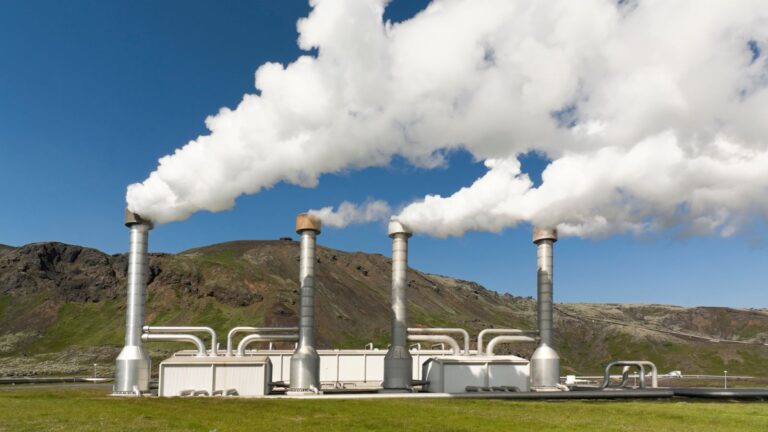This report represents the research and views of the author. It does not necessarily represent the views of the Center on Global Energy Policy. The piece may be subject to further revision. Contributions to SIPA for the benefit of CGEP are general use gifts, which gives the Center discretion in how it allocates these funds. More information is available at Our Partners. Rare cases of sponsored projects are clearly indicated. For a full list of financial supporters of the Center on Global Energy Policy at Columbia University SIPA, please visit our website at Our Partners. See below a list of members that are currently in CGEP’s Visionary Annual Circle.
-
CGEP’s Visionary Annual Circle
-
(This list is updated periodically)
Occidental Petroleum Corporation
Executive Summary
The Pacific Gas and Electric (PG&E) bankruptcy, which was caused by liabilities resulting from massive wildfires, has widely been called the first climate change bankruptcy. It will likely not be the last, as climate change exacerbates natural disasters, leading to more frequent and intense wildfires, storms, and flooding. Wildfires alone could become up to 900 percent more destructive in certain regions by midcentury, and utility assets will also be increasingly exposed to threats stemming from hurricanes, rising sea levels, and other climate-related events.
These extreme weather events will increase costs to utility-sector stakeholders, including investor-owned utilities, state and local governments, ratepayers, and taxpayers. These risks could place financial stress on utility companies, drive up electricity rates, crowd out essential investment in renewable energy and grid upgrades, and disrupt service.
In this paper, Columbia University’s Center on Global Energy Policy reviews and analyzes the PG&E bankruptcy, assesses how capital markets have reacted to the bankruptcy through the lens of valuations in the US utility sector, and discusses policy implications of California’s recent legislative response to wildfire risk. This paper examines market indicators to assess investor expectations of climate risk exposure and likely cost allocation. Neither debt nor equity markets suggest widespread concern about climate risk in the utility sector.
In the absence of strong market signals to encourage climate risk mitigation, the authors find that policy frameworks are needed to ensure that companies make necessary preventative investments and to define how costs will be allocated among stakeholders. This paper also reviews a recently passed California bill aimed at achieving these objectives and the lessons and best practices it offers for other policy makers. In short, the paper finds the following:
- Market indicators suggest that the California wildfires and subsequent PG&E bankruptcy have not caused imminent concern about climate risks in the utility sector. Equity valuations for the sector remain strong, with a utility stock index trading at a higher-than-average premium to the market benchmark. In credit markets, regulated utilities in the United States have raised more than $50 billion of corporate debt in 2019 to date, and borrowing spreads are currently below historical averages.
- There are several reasons why markets may not reflect widespread climate risk to utilities, despite the scientific evidence around likely future damage. Investors may believe that cost increases from climate change will occur too far in the future to materially impact the present value of their investments. Even if investors believe that climate change risks are material to valuation, they may also believe that such risks will not be considered by other investors for some time. Investors may be viewing wildfires as a California-specific risk, though the regional skew of wildfires is likely to shift significantly in coming years. They may lack the information or modeling tools for assessing the likelihood and geographic dispersion of high-impact tail events, such as the wildfires that PG&E faced.
- Financial markets may also reflect the belief that the costs of climate change in the utility sector will fall predominantly on ratepayers, insurance companies, and/or taxpayers rather than investors, and therefore investors may not view themselves as materially exposed.
- California’s recent creation of a wildfire insurance fund with contributions from both ratepayers and companies provides important policy lessons for designing comprehensive frameworks to allocate climate damage costs. These include the strengthening of both regulatory and corporate climate resilience expertise, mandating preventative investment as a prerequisite for cost-recovery mechanisms, defining utility financial exposure for climate damage situations, and providing cash for utilities to provide essential services when facing large disasters.
- The policy also presents some potential pitfalls that may be instructive for other state policy makers. The legislation sets aside large reserves for future damage, a necessary measure, but one that will result in higher electric bills. The bill does not allow utilities to earn a return on safety-related spending, which broadly diminishes incentives for proactive climate mitigation investment. The potential insufficiency of the wildfire fund also creates uncertainty about future cost allocation. Finally, failing to reform the California legal framework that allows utilities to be held liable for damages they did not cause perpetuates risks for companies and ratepayers.
If the first climate change bankruptcy is indicative of a new reality, it is not that utilities are going to go bankrupt overnight. Rather, climate disasters will increasingly add financial stress to utility-sector stakeholders, as costs accumulate from both acute events and damaging extreme weather impacts. Adapting the regulatory bargain for a climate-exposed future will require lawmakers, regulators, and shareholders to develop new approaches and new incentive structures to ensure an accountable, robust utility sector. Moreover, while climate change is already presenting real financial challenges to utilities, it will not be the only sector to face large climate-driven costs. Other corporate actors can look to the utility experience to better understand how policy makers, investors, and companies will respond to the growing financial threat from climate change.




